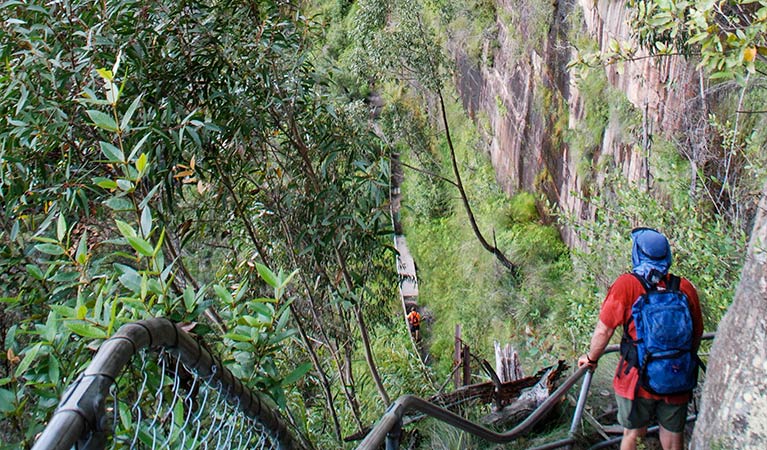School excursion
Crossing the Blue Mountains
Blue Mountains National Park
Overview
This Stage 2 (years 3-4) History excursion immerses students in the History of the Mount York area. We examine the remains of the early Cox’s Road, walk in the foot-steps of explorers and First Nations people and consider how significant individuals, groups and events contributed to changes over time.
Read more about Crossing the Blue Mountains
We describe and explain the effects of British colonisation in Australia and implications of Crossing the Mountains.
In this excursion students recall Australia’s colonial days of early European exploration and this momentous event which changed our history.
As well as exploring the physical sites, students will use their imaginations to consider the diverse experiences of explorers, convicts and Indigenous Australians. How did the mountain crossing impact these people and the broader development of Australia?
On a scenic walk through the pagodas of Mount York, we will see evidence of carriages and livestock passing over the mountain to establish farms in the west country below. Students will look at the lives of local Indigenous people both before, and after the mountain crossing, and consider the ethics of our country’s history.
For program outline, safety and practical information about this excursion, see info for teachers
| Stage | Stage 2 (Years 3-4) |
|---|---|
| Learning area | History |
| Student outcomes |
HT2-2. Describes and explains how significant individuals, groups and events contributed to changes in the local community over time HT2-4. Describes and explains effects of British colonisation in Australia HT2-5. Applies skills of historical inquiry and communication |
| Objectives |
Students will:
|
Excursion details
- When
Monday to Friday during school term.
- Duration
- 2-4 hr
- Grading
- Easy. Short 1km ranger-guided bush walk and activities, includes uneven surfaces in the bushland environment.
- Price
-
Prices start from $395 incl GST per group (up to 20 students).
- Accessibility
- Medium
- Meeting point
- Mount York Lookout.
- Equipment
provided - No. We can provide teachers a selection of student worksheet questions prior to excursion.
- Booking
- If you would like to organise a NPWS school excursion please get in touch with local staff or use the 'Enquire' link for the online form.
Local alerts
For the latest updates on fires, closures and other alerts in this area, see https://www.nationalparks.nsw.gov.au/education/stage-2-hsie-crossing-the-mountains-mt-york-blue-mountains-national-park/local-alerts
Operated by
- School excursion inquiries - Blue Mountains
- 02 4784 7301 Monday, Tuesday, Thursday and Friday
- BlueMtns.Education@environment.nsw.gov.au
Park info
- in Blue Mountains National Park in the Sydney and surrounds and Country NSW regions
Blue Mountains National Park is always open but may have to close at times due to poor weather or fire danger. Some parts of the park close overnight; details are provided for specific attractions.
-
Park entry fees:
$8 per vehicle per day applies only at attractions in the Glenbrook area.
Buy annual pass.
Info for teachers
All the practical information you need to know about Crossing the Blue Mountains.

